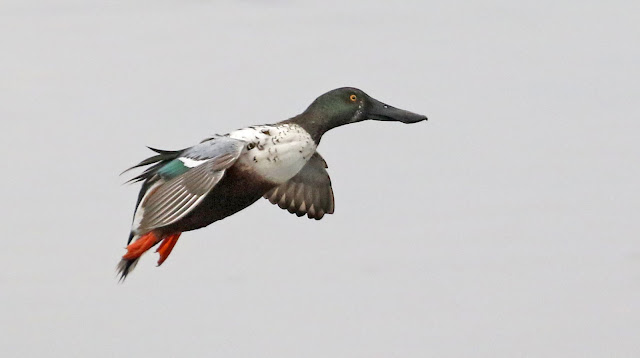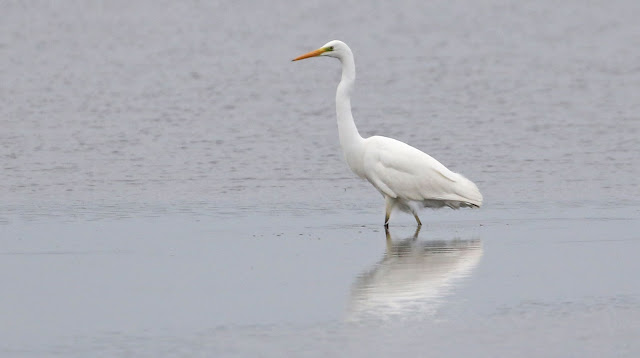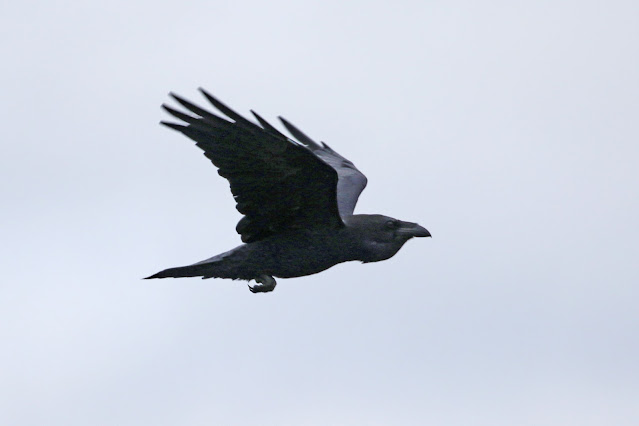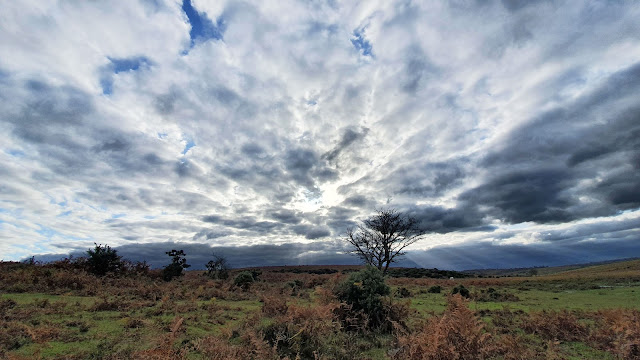Driving west in the dark this Saturday morning I was amazed at the amount of traffic on the road, then I realised it was because it was just before 7:00 am! The days have shortened very quickly over the last few weeks and as I pulled into the car park at Lower Pennington Lane just before 7:30 it was still very gloomy, with sun rise another fifteen minutes away. Adding to the gloom was the overcast conditions which was a little disappointing given the lovely day before and clear conditions in the evening.
After Ian arrived we walked across the Old Tip on the west side, a Stonechat appeared on a dead tree silhouetted against the gloomy dawn sky.
Looking across the back of Fishtail the numbers of wildfowl had significantly increased and the Wigeon, Teal and Pintail were now showing off there stunning breeding plumage. It was gloomy still, but the water was very calm and the duck were reflecting nicely. With the gloom the photographs were very grainy so I turned once again to black and white, but I have also retained the originals to compare. I prefer the black and white photos as this loses the grain and therefore the lack of detail you would want to see in a coloured image. The black and white image also provides more of an artistic intent.
I kind of feel the consensus of those who view my photographs is that they don't like the black and white images, but I feel it has a place. I suppose it depends on if you want to look at the bird or a photograph.
Heading to the sea wall required negotiating the presence of what were some very large cows, You have to believe they are friendly and wouldn't bother you but they were very large animals and you never know, you hear so many stories of cattle that suddenly attack.
In the pool alongside the footpath at Fishtail the juvenile Little Grebe was still calling, but the one adult I could see was not very interested. Wigeon seem to like the grass bank and I disturbed several that moved quickly to the main lagoon. Like the Pintail they are now in full breeding plumage.
Scanning across the lagoon the water level was very high and there were no birds of note to be seen. In Butts Bay the tide was rising and there was quite a few waders feeding. Close to the sea wall were Black-tailed Godwits, Redshank and a single Greenshank. In an effort to get a closer view I walked to the corner, but as I raised the tripod it spooked the birds and then flew to the mud around the rocks.
Scanning once again I was able to add Grey Plover, Dunlin and Ringed Plover to the count and out on a small island a single Bar-tailed Godwit.
A search across the saltmarsh for a Peregrine sitting on a post didn't workout, but surprisingly there was an immature / female type Marsh Harrier sitting on a rock, not something we had both seen here before.
Out on the sea small groups of Brent Geese would fly west, their numbers gradually increasing and up significantly on those present two weeks ago.
We set off to walk to Normandy Marsh, again through the week a Pectoral Sandpiper has been reported around the Oxey - Normandy Marsh area. As always the reports were through the week and that usually means that they go come the weekend, but we are nothing if not optimistic.
On the Pennington Lagoon just past the Jetty was a single Spotted Redshank.
As we watched the Spotted Redshank a pair of Shoveler flew in, the drake holding up the rear, gliding in for the perfect landing
Here after catching a fish the gullet swells as it is swallowed
The reports of this elegant water bird have increased significantly this year. I can't recall taking so many photographs of Great Egret before. White birds are always a challenge, here the slate grey background of the water in the lagoon helped.
An attempt to get down to the same level as the egret only resulted in flushing the egret, but fortunately it did not fly too far and dropped back down to continue fishing
The fishing technique is the same as the Little Egret, hunting by sight, using its feet to disturb the bottom of the lagoon and force prey out. This follows with a lightning fast strike into the water.
An alternative background to challenge the exposure once again.
A Raven had been seen at the back of Pennington Lagoon earlier, but as we watched the egret the familiar "gronk" alerted us to it flying across Oxey Lagoon giving some great views
Size of the bird and the bill clearly separating it from the more commoner Crows
As the sea wall turns north and forms the south east corner of Oxey Marsh, it is a good place to scan the sea, the tide was coming in quite quickly and amongst the eight Great Crested Grebes I found the reported Slavonian Grebe. However as I tried to point it out to Ian it completely disappeared and despite the best efforts of both of us we could not re-locate it.
I was beginning to doubt that I had even seen it, it was so strange how it had just gone. We walked on, but continued to scan the sea, then on one of those scans I found it. The grebe was on its own and a long way out on the water to completely avoid the camera. Still it was nice to see a first for the year through the 'scope.
As well as the grebes out on the water there was also four Red-breasted Mergansers, my first of the year and three Eider
Stonechats are always photogenic and perch so confidingly, this one on the north east corner of Oxey Marsh.
On the other side of the water a Curlew stood on the edge casting its reflection into the still water, its plumage contrasting nicely with the surrounding colours of the marsh.
On the other side of Moses Dock a Kingfisher was flushed and of course flew off never to return, on the marsh itself at Salterns were several Redshank.
We arrived at Normandy very much in hope rather than anticipation. It quickly became clear that hope was fading quickly. There were good roosts of Dunlin, Redshank and Ringed Plover, but there was no sign of anything that resembled a Pectoral Sandpiper.
In the week there had been reports of Merlin and Short-eared Owl as well but of course these were not to be seen on a Saturday. There were , though, large flocks of finches, Linnet, Goldfinch and Greenfinch, feeding on the saltmarsh. There were also several Skylarks and Meadow Pipits.
We walked all the way around to the far side of the marsh where a few Teal were close enough to photograph roosting in the water.
Walking back the Dunlin were beginning to stream in from the mud, so it was no surprise to find that some birders had found an adult Little Stint on one of the islands. Here at best a record shot as it fed on the grass of the island.
We had seen the odd swallow on our walk, but now the trickle became a flow as many came across the marsh and then out across the sea, some using the marsh to dunk in the water before heading off. This will probably be the last significant number of Swallows for the year, although there is always the chance of a straggler turning up.
Stomachs were rumbling and won over the urge to stay and hope the sandpiper appeared as the tide continued to rise. We put our money on if it did it would probably appear on Oxey Marsh, the place it had been seen more frequently.
The marsh was quiet with a few roosting Black-tailed Godwits and Redshank, off shore there was no sign of the Slavonian Grebe, the number of Great Crested Grebes it had been associating with having reduced. One Great Crested Grebe was diving close into the sea wall
Coming around to Oxey Lagoon a Greenshank was showing well close to the bank of the marsh
The Great Egret was still fishing on the lagoon, but didn't stay long, flying away to the east. The Spotted Redshank was present having moved from Pennington Lagoon and sitting nicely between two rocks
The long bill and legs give it a more elegant appearance than its cousin the Common Redshank.
On reaching the Jetty there was a small group of photographers focused on the Turnstone feeding amongst the sea weed and bladder wrack washed up on the tide line. One member of the public asked us what the birds were and as Ian turned to show them I noticed a diver coming from the east and heading west quite close in.
A Red-throated Diver, the one diver I seem to have difficulty with in Hampshire so it was nice to see
Walking up on to the old tip there was a large flock of Goldfinches feeding on the thistles and old seed heads both on the plants and on the ground.
There was a good high tide roost of Black-tailed Godwits at the back of Fishtail, along with a good number of Redshank. The stand out bird though was this lovely white Ruff. Here digiscoped.
This taken with the camera
Reports of Merlin and Hen Harrier around Leadenhall and Black Gutter Bottom in the New Forest through the week had us decide to return. After some lunch we made our way through the traffic around Lyndhurst and arrived at the parking place on Roger Penny Way around 14:00
The walk down towards Black Gutter Bottom was a complete contrast to last week, there were just no birds. On the plateau we saw two "black" birds and calls from one of the Hawthorn trees produced a single female Ring Ouzel, it flew from the tree and was not relocated. Patience was not on hand so we walked down towards Ashley Hole where we could hear the Fallow Deer grunting. They were very distant and this was the best we could get.
As well as the deer we could see distant flocks of thrushes, probably Redwing flying around above the horizon, but so, so distant
We then spent some time chasing an invisible Dartford Warbler, finally managing to get glimpses as it flew from gorse to gorse.
Walking back across the plateau there were some lovely, dramatic skies developing. Shards of light scattering across the distant Pitts Wood Inclosure
Dramatic clouds above Ashley Walk and Cockley Plain
Realising that there was not going to be any dramatic finds on the plateau we headed back down to Black Gutter Bottom. There was always hope, there has to be, but with a big dollop of realism. At least we had the opportunity to enjoy the views around us as the sun began to break through clouds that up to now had just been a dense blanket
And sending patterns across the sky above the stream at Black Gutter Bottom
Heading up to the car on the other side of the stream I turned to see the infamous birch tree on the horizon. The clouds were breaking above it and I felt it deserved a black and white treatment, I can't keep taking the same view!
As we reached the cars, a surprise, a bird , a male Stonechat balancing on a gorse branch in the freshening breeze
No Harrier, no Merlin, again. But a semi successful day around Pennington and Normandy. We did manage to get the Slavonian Grebe and the Red-throated Diver was a bonus. It was good to be out and about, always a bonus at the end of the week.




















































